This article needs additional citations for verification .(September 2021) |
 | |
| Type | Digestif |
|---|---|
| Country of origin | Balearic Islands, Spain |
| Alcohol by volume | various |
| Proof (US) | various |
| Color | Green/Amber |
This article needs additional citations for verification .(September 2021) |
 | |
| Type | Digestif |
|---|---|
| Country of origin | Balearic Islands, Spain |
| Alcohol by volume | various |
| Proof (US) | various |
| Color | Green/Amber |
The Hierbas liqueur has its roots on the Balearic Islands. Monks already living there during the Middle Ages were already cultivating the wild herbs and alcohol for medicinal use, so a strong tradition existed for the production of the liqueur. However, it wasn't until the late 1800s that the actual production of Hierbas was formalized, utilizing techniques obtained from travellers to the mainland of Spain.
Hierbas is an aniseed-flavored liqueur made mainly by extracting aromas of various plants such as fennel, thyme, rosemary, Luisa herbs, lavender, rue, eucalyptus, chamomile, juniper berries, juniper, marjoram, mint, healthy grass, leaves and peels from lemons and oranges, and sage in the presence of other plants such as star anise and green anise or matafaluga. [2] [3]

Gin is a distilled alcoholic drink that derives its predominant flavour from juniper berries.

A liqueur is an alcoholic drink composed of distilled spirits and additional flavorings such as sugar, fruits, herbs, and spices. Often served with or after dessert, they are typically heavily sweetened and un-aged beyond a resting period during production, when necessary, for their flavors to mingle.
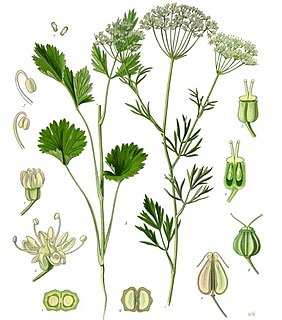
Anise, also called aniseed or rarely anix, is a flowering plant in the family Apiaceae native to the eastern Mediterranean region and Southwest Asia.

Caraway, also known as meridian fennel and Persian cumin, is a biennial plant in the family Apiaceae, native to western Asia, Europe, and North Africa.
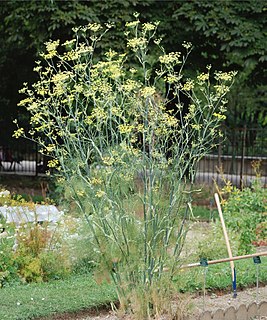
Fennel is a flowering plant species in the carrot family. It is a hardy, perennial herb with yellow flowers and feathery leaves. It is indigenous to the shores of the Mediterranean but has become widely naturalized in many parts of the world, especially on dry soils near the sea-coast and on riverbanks.

Liquore Galliano L'Autentico, known more commonly as Galliano, is a sweet herbal liqueur, created in 1896 by Italian distiller and brandy producer Arturo Vaccari of Livorno, Tuscany and named after Giuseppe Galliano, an Italian officer of the Royal Italian Army of the First Italo-Ethiopian War.
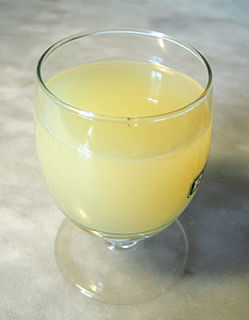
Pastis is an anise-flavoured spirit and apéritif traditionally from France, typically containing less than 100 g/l sugar and 40–45% ABV.
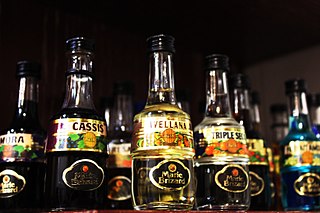
Anisette, or Anis, is an anise-flavored liqueur that is consumed in most Mediterranean countries. It is colorless, and because it contains sugar, is sweeter than dry anise flavoured spirits. The most traditional style of anisette is that produced by means of distilling aniseed, and is differentiated from those produced by simple maceration by the inclusion of the word distilled on the label. And while Pastis is a similar-tasting liqueur that is prepared in similar fashion and sometimes confused with anisette, it employs a combination of both aniseed and licorice root extracts. Sambuca is essentially an anisette of Italian origin that requires a high minimum (350g/l) sugar content.

Jägermeister is a German digestif made with 56 herbs and spices. Developed in 1934 by Wilhelm and Curt Mast, it has an alcohol by volume of 35%. The recipe has not changed since its creation and continues to be served in its signature green glass bottle. It is the flagship product of Mast-Jägermeister SE headquartered in Wolfenbüttel, Germany.
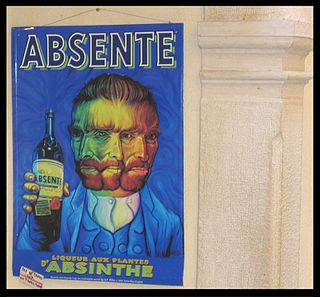
Absente is a brand name of 110 proof anise liqueur that has been marketed under the tagline "Absinthe Refined" since c. 2000. "Absente" is a French word that translates as "absent" in English.

Angelica archangelica, commonly known as garden angelica, wild celery, and Norwegian angelica, is a biennial plant from the family Apiaceae, a subspecies of which is cultivated for its sweetly scented edible stems and roots. Like several other species in Apiaceae, its appearance is similar to several poisonous species, and should not be consumed unless it has been identified with absolute certainty. Synonyms include Archangelica officinalis Hoffm. and Angelica officinalis Moench.

Aguardiente, in Spanish, or aguardente, in Portuguese is a generic term for alcoholic beverages that contain between 29% and 60% ABV. It originates in the Iberian Peninsula, as well as Iberian America.
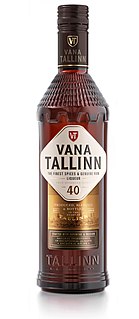
Vana Tallinn liqueur is one of Estonia’s hallmark products, manufactured continuously at Liviko since 1960. The spicy flavour of Vana Tallinn liqueur is derived from Jamaican rum, herbs, various spices from around the world, oranges and lemons. Only natural ingredients are used to make Vana Tallinn, including real vanilla pods. The recipe contains more than ten ingredients in total. The recipe for Vana Tallinn was invented in 1960 by the master distiller Ilse Maar, the bottling manager Bernhard Jürno and the distillery specialist Jaan Siimo.

Nalewka, plural nalewki, is a traditional alcohol from Poland. Similar to medicinal tinctures, it is usually 40% to 45% alcohol by volume, though some can be as strong as 75%. Nalewka is created by macerating and / or infusing various ingredients in alcohol, usually vodka or neutral spirits. Among the ingredients often used are fruits, herbs, spices, roots, sugar and honey. The name nalewka is currently being registered for national appellation within the European Union. Unlike ordinary liqueurs, nalewkas are usually aged. Since nalewka is produced by infusion rather than distillation, the liquid is typically colorful and somewhat opaque. Taste-wise, nalewka is similar to fruit liqueurs such as schnapps or eau-de-vie, but is usually sweeter and typically lacks a strong alcohol taste.
Flavored liquors are liquors that have added flavoring and, in some cases, a small amount of added sugar. They are distinct from liqueurs in that liqueurs have a large sugar content and may also contain glycerine.

Amaro is an Italian herbal liqueur that is commonly consumed as an after-dinner digestif. It usually has a bitter-sweet flavour, sometimes syrupy, and has an alcohol content between 16% and 40%.
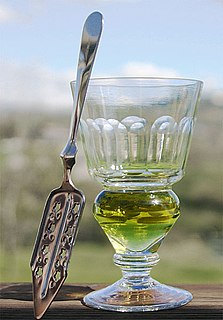
Absinthe is an anise-flavoured spirit derived from several plants, including the flowers and leaves of Artemisia absinthium, together with green anise, sweet fennel, and other medicinal and culinary herbs. Historically described as a highly alcoholic spirit, it is 45–74% ABV or 90–148 proof US. Absinthe traditionally has a natural green color but may also be colorless. It is commonly referred to in historical literature as la fée verte. It is sometimes mistakenly referred to as a liqueur, but is not traditionally bottled with added sugar and is, therefore, classified as a spirit. Absinthe is traditionally bottled at a high level of alcohol by volume, but it is normally diluted with water before being consumed.

Herbs de Majorca is a Majorcan herbal liqueur made from anise and other aromatic plants such as camomile, fennel, lemon, lemon verbena, marjoram, mint, orange, and rosemary.